Last year the Zenfone 2 series was amongst my recommendation list, the Zenfone series phones I felt were easy for not-so-techie people to use and it was. People who bought it upon my recommendation had no complaints and they found it easy to use. Also, it was an affordable range. There was a Zenfone model for everyone at almost all price bands. With new models coming in every literally every week, the Zenfone 2 ceased to be relevant both in design and specs. Asus announced the Zenfone 3 series that include Zenfone 3, Deluxe and Ultra. The new lineup marked a paradigm shift for the Taiwanese company. They refused to go by the ultra-low cost business model and so the new Zenfone 3 devices are now suddenly elevated to a premium devices in each of the category it is positioned. What I got here is the Zenfone 3 ZE552KL the top variant of the Zenfone 3 subset priced at Rs 27,999, which also has a step down model ZE520KL available at Rs 21,899. Now, lets dig into my Zenfone 3 review.
Design, Build and Display
- Glass body, metal frame
- 2.5D Corning Gorilla glass on both sides
- 152.59 x 77.38 x 7.69 mm
- 155 grams
- Colors: Sapphire Black/Moonlight White/Shimmer Gold
Asus has shed its ‘plastic-ky’ past and embraced new contemporary design language for the Zenfone 3. It has bid goodbye to the polycarbonade and indulges on glass and metal for a premium offering. Its unlike any of the Zenfone devices we have seen so far but the signature concentric circles are still incorporated on the back side and it looks good. It is not visible on the white bodied phone that I have is another story. While shifting to new materials does give a contemporary look and feel, unlike the solid previous generation phones, this phone could be prone to damages if you have a slippery hand.
The handset fits ergonomically well with its rounded corners and smooth, curved sides. At 155 grams, its not the lightest but feels assuring on hands. At 7.69mm , it is even slightly thicker than OnePlus 3 and Samsung A7. If only Asus has chiseled the bezels a little more, it would have been slightly more compact width-wise.
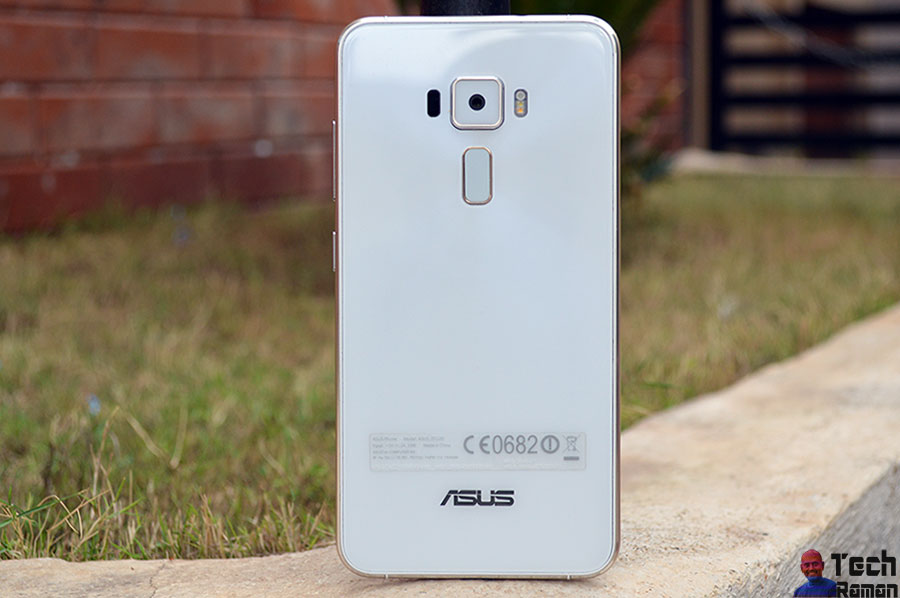
I hate camera bumps and it is very prominent here, the only issue I have with the otherwise elegant looking phone. A sapphire lens makes sure it doesn’t gets scratched but I always fear pressing down the phone when on a hard surface. There are two many geomatric patterns on the rear. The finger print sensor is rectangular, the camera set up is square with a round lens at its center, a rectangular rounded laser sensor and dual LED flash flanks the camera. It’s crowded at the top, while a bold ASUS branding sits at the bottom.
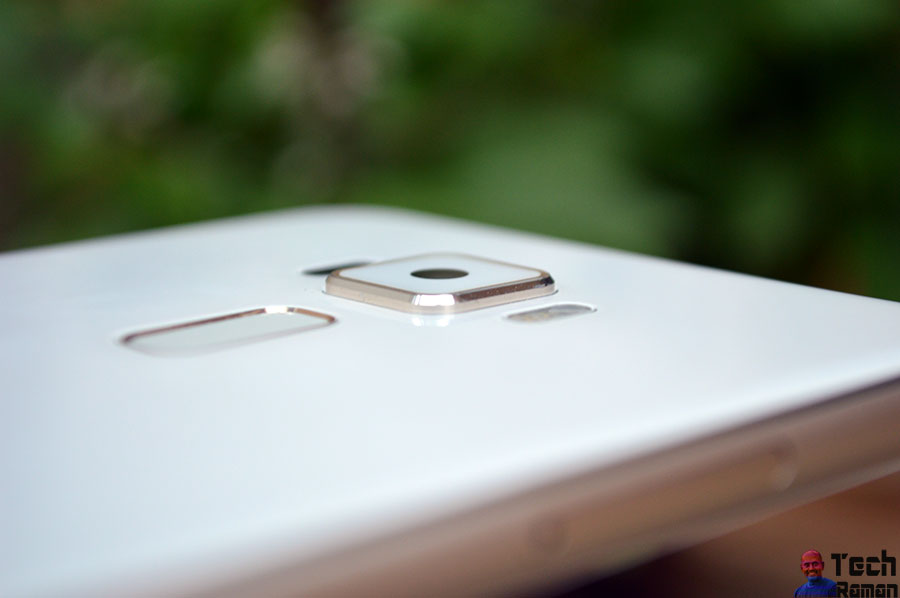
The top houses the 3.5mm audio jack and a microphone. The antenna cutouts as white thin stripes are on the top and bottom.
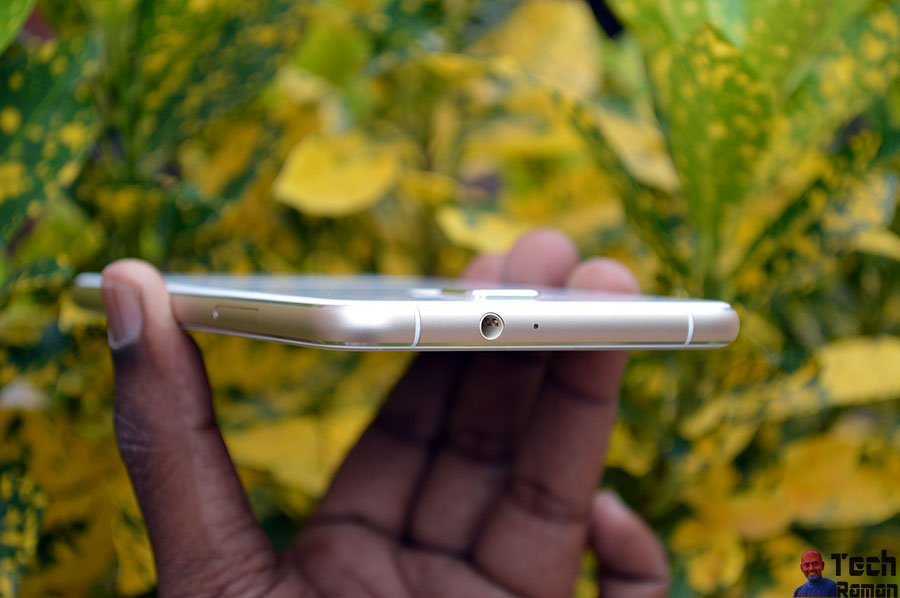
The bottom has the type-C USB port, another microphone and a two rows of pinholes for speaker.
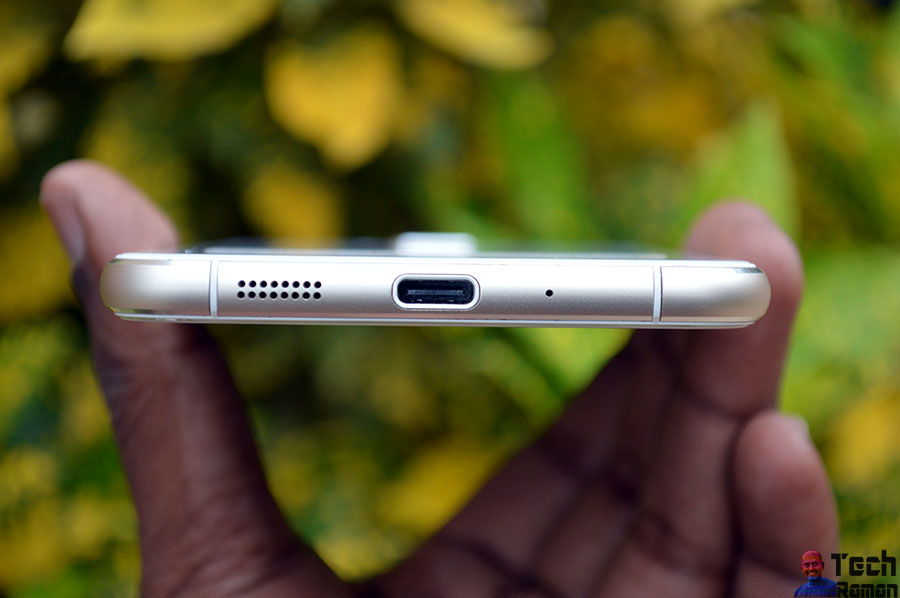
The right side houses the power button and volume rocker, both flaunting again the circular pattern on their tiny spaces. The left side has a hybrid dual-SIM tray, which can be ejected with a pin. The front face has capacitive buttons on the chin but they are not backlit, which ideally should have been at this price range. There are clear markings though to show the buttons. The top houses the earpiece grille, sensors and a selfie camera.
- 1920 x 1080
- 600 nits
- 2.1mm bezel
- 77.3% screen to body ratio
The ZE552KL variant of the Zenfone 3 we are talking about in this review has a 5.5-inch fullHD display , while the ZE520KL variant is slightly compact with a 5.2-inch display. I prefer big displays and this variant suits me personally. The display is not the most vibrant, eye-popping screens I have come across, though its still a good one. If you are someone who likes a bit over-saturated AMOLED type displays this would look more natural. The 600 nits brightness makes for good readability both indoors and under direct sunlight. The viewing angles are great too. The display settings allows you to shift the temperature and also offers a balance, vivid and a customize option where you can adjust the hue and color, in case you want to. There is also the Bluefilter toggle for reading mode.
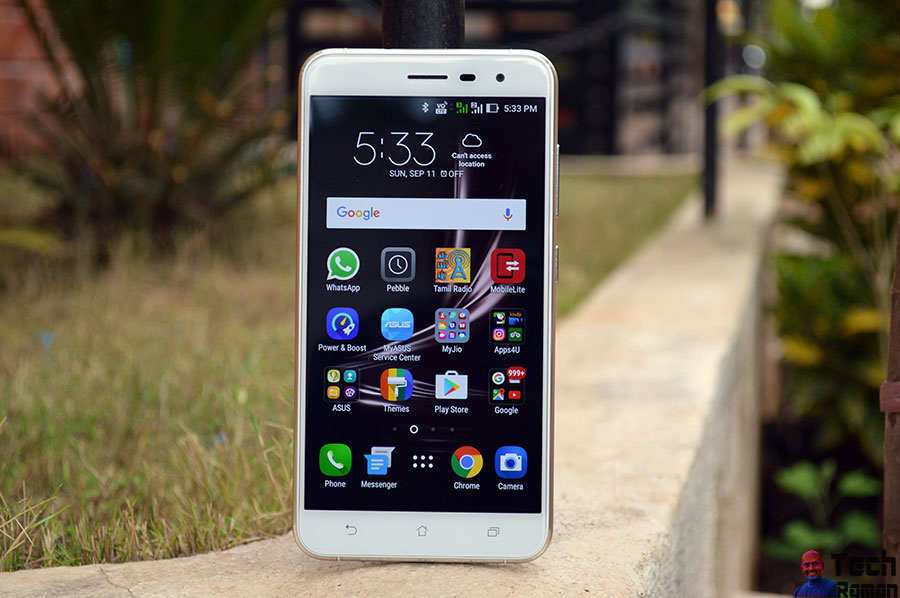
Software – UI for the masses
- Android 6.0.1 Marshmallow
- ZenUI 3.0
Frankly, I quiet like the ZenUI from an average consumer’s point of view. It is colorful and is easy to use. It also has many interesting features that would appeal the consumers. There are
quick access shortcuts to three apps that can be directly accessed from lockscreen and it can be customized.
Manage home section allows the users control over various aspects like icon size, alignment, label color, font size of the label and more. An
all-in-one search bar helps you to search apps, contacts, settings plus google all at one place. Settings page is neatly divided and there are features like
easy mode,
kids mode etc plus there is a
theme section to give a makeover.
Auto-call recording may not be legal at some countries but many do prefer this feature like my neighbour who records the calls and takes notes of the point of discussions later, the ZenUI supports that.
ZenMotion settings offer touch gestures where you can draw gestures to open particular associated apps and also motion gesture to connect incoming call by lifting the phone to the ear.
Of course, as usual Asus has pushed in
bloatwares and preinstalled with apps like Puffin, Tripadvisor, SIM city, power boost app which you could do away with. Also, there is a
mobile manager app which is an one-stop to check the data usage, get into various power modes, notification controls and take a note of various app permissions. Also, hidden here is the app lock setting.
If you are more interested in knowing all the features the ZenUI offer, please take a look at the video below. There is also a one-handed mode if you feel the screen is bigger sometimes, it reduces the screen size.
https://youtu.be/dGA0di2Qpik
Hardware and Performance
- Qualcomm MSM8953 Snapdragon 625
- Octa-core 2.0 GHz Cortex-A53
- 4GB RAM
- Adreno 506
- 14nm processor
- 4G /VoLTE
- 64GB Storage
- 3000mAh battery
- USB Type-C port
- Sensors: Fingeprint, accelerometer, gyro, proximity, compass
- Dual SIM (Nano-SIM/ Micro-SIM, dual stand-by)
The above specs slightly varies with the Zenfone 3 ZE520KL which is not just features a compact 5.2-inch display but also a smaller 2600mAh battery and is available in 3GB / 3GB and 4GB / 64GB variant. The overall performance though should not be drastically different.
Purely on spec sheet comparison, the Zenfone 3 would not excite in this premium mid-range slab. OnePlus 3 in comparison has a Snapdragon 820 and very recently the Lenovo Z2 Plus (Zuk 2) was launched in India for less than Rs 20,000 boasting again a 820 chip inside. Then we have the Xioami Mi 5 whose price has also tumbled down. So the Snapdragon 625 pales before the rivals at least on paper and on theoretical discussions. Does it?
Yes, 820 is undoubtedly a better SoC than the 625 but after using the Zenfone 3 for a month now for all practical purposes, the 625 proved to be a smooth operator. The Zenfone 3 is a very stable device. It performs all the tasks impressively well in regular usages. Regular tasks like calling, messaging, browsing along with some multi-tasking proved to be an easy walk and when it comes to gaming it does decently well. Yes, it might not have the hardware muscles the more robust 820 offers but for most part it works well. If your gaming is not the primary focus on a device and the Zenfone 3 is for you. Not that games like NOVA 3, Asphalt 8 are not playable, it does but might miss few marks here and there in the performance if you have played on more powerful devices. The Adreno 506 GPU handles the graphics pretty well.
What is very impressive about the Zenfone 3 for me though is its battery life. It is brilliant. With a dual-SIM with 4G always on and on heavy usage, it could easily last one full day. I never ran short of the battery during the middle of the day, even if I indulged on streaming in between or played few bouts of games. This phone holds the battery juices really well for you. Plus, it can tank up full in under 2 hours.
What was disappointing is inspite of all the customization options the UI offers, there is no means to use the finger print sensor to lock the apps. Yes, you can unlock the phone, use the finger print sensor to answer incoming calls, launch camera and trigger a click but there is no option to secure apps with finger print sensor, you can do that of course with password or pattern lock. The fingerprint sensor is quiet fast and very accurate though.
Camera
- 16MP rear camera
- Sony IMX 298 sensor
- f/2.0 aperture
- 6P largan lens
- $-axis OIS & EIS
- Sapphire lens protection
- 4K video capable
- Laser, PDAF, continuous focus
- 8 MP selfie camera
- f/2.0 aperture
- 1080p video capable
The Zenfone 3 ticks all the checkpoints on the optics list but the larger question is how capable is the camera? Here are my observations.
- The color reproduction is brilliant
- Lacks the extra sharpness if you have detailed eye for it
- Macro focus is not very impressive
- Depth of field is good
- low light performance is decently good
- HDR does highlight the shadows but is not dramatic otherwise
- Video quality is good
Typical of the ZenUI we have seen so far, the camera app has extensive more than a dozen camera modes and is more
average Joe Munna bhai friendly in terms of ease of use. The selfie mode has option to detect predefined number of faces and click automatically once it maps the face, a convenient timer can give you enough time for perfect selfie. In short, the Zenfone 3 is not your camera phone but a good phone with a decent camera. Here are few samples for your reference.
[gallery link="file" columns="5" ids="11676,11677,11678,11679,11680,11681,11682,11683,11684,11685"]
Conclusion
 What I liked
What I liked
- Battery life
- Smooth overall stable performance
- New design language Asus has adopted
- Audio quality
 What I did not like
What I did not like
Would I recommend Zenfone 3? No and Yes, depending on who asks me. Typically, there are two sets of buyers. One set who are comfortable buying devices online and then there are those who are comfortable only picking their devices from offline retail stores. The former set of consumers sieve the tech specs and go for more value for money proposition, for them I would not be recommending Zenfone 3 as the first choice but still would mention them amongst the list. When it comes to retail store buyers with Rs 30,000 in hand and looking for phone, Zenfone 3 it is. It is good to see Asus want to break from the pricing war, which might be the healthier way to sustain in the longer run as a company but still they could have been more reasonable with the pricing for Zenfone 3 especially in a price-sensitive market like India. Offline or online, the Zenfone 3 still is a overall great phone, if you don’t mind shelling out the little extra.]]>
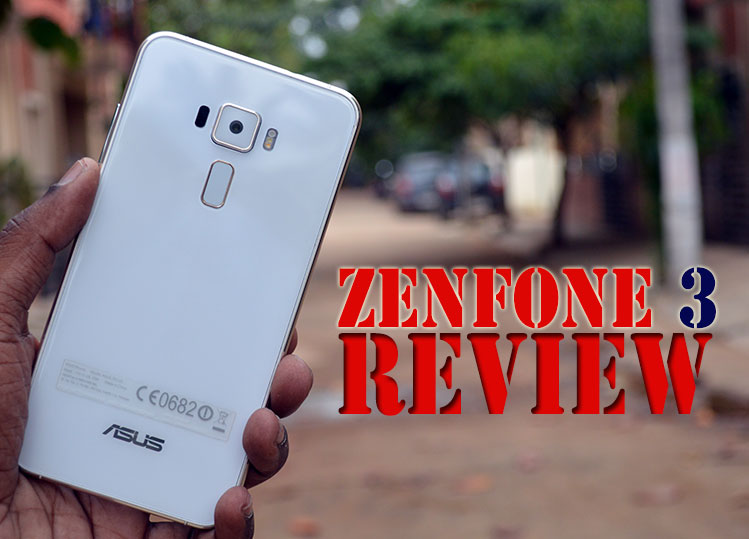
 I hate camera bumps and it is very prominent here, the only issue I have with the otherwise elegant looking phone. A sapphire lens makes sure it doesn’t gets scratched but I always fear pressing down the phone when on a hard surface. There are two many geomatric patterns on the rear. The finger print sensor is rectangular, the camera set up is square with a round lens at its center, a rectangular rounded laser sensor and dual LED flash flanks the camera. It’s crowded at the top, while a bold ASUS branding sits at the bottom.
I hate camera bumps and it is very prominent here, the only issue I have with the otherwise elegant looking phone. A sapphire lens makes sure it doesn’t gets scratched but I always fear pressing down the phone when on a hard surface. There are two many geomatric patterns on the rear. The finger print sensor is rectangular, the camera set up is square with a round lens at its center, a rectangular rounded laser sensor and dual LED flash flanks the camera. It’s crowded at the top, while a bold ASUS branding sits at the bottom.
 The top houses the 3.5mm audio jack and a microphone. The antenna cutouts as white thin stripes are on the top and bottom.
The top houses the 3.5mm audio jack and a microphone. The antenna cutouts as white thin stripes are on the top and bottom.
 The bottom has the type-C USB port, another microphone and a two rows of pinholes for speaker.
The bottom has the type-C USB port, another microphone and a two rows of pinholes for speaker.
 The right side houses the power button and volume rocker, both flaunting again the circular pattern on their tiny spaces. The left side has a hybrid dual-SIM tray, which can be ejected with a pin. The front face has capacitive buttons on the chin but they are not backlit, which ideally should have been at this price range. There are clear markings though to show the buttons. The top houses the earpiece grille, sensors and a selfie camera.
The right side houses the power button and volume rocker, both flaunting again the circular pattern on their tiny spaces. The left side has a hybrid dual-SIM tray, which can be ejected with a pin. The front face has capacitive buttons on the chin but they are not backlit, which ideally should have been at this price range. There are clear markings though to show the buttons. The top houses the earpiece grille, sensors and a selfie camera.

 What I liked
What I liked What I did not like
What I did not like
